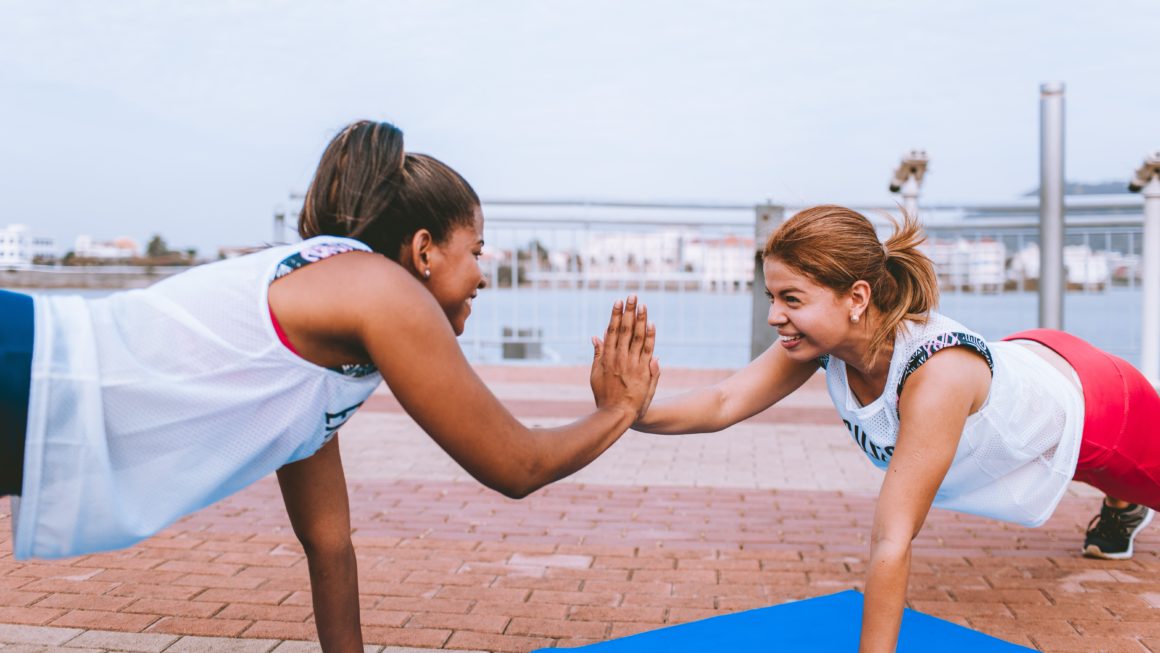By Katrina Vinson
Are you sticking to your New Year’s Resolution? Every January 1st, many of us promise ourselves that this is the year we will eat better, sleep more and hit the gym, but statistics show that only around 8-9% of new year’s resolutions stick (1). Wellness fads seem to explode onto the scene at the start of the year. Anything from nutrition shakes to new gym equipment promise to be the secret ingredient that will not only help you keep your resolutions, but will also achieve your goals. Are you struggling to decide between popular trends that produce results and those that are full of fluff? I’m here to help. Here are my top 3 fitness “trends” for 2019 that will truly help you optimize your health and fitness goals.
High-Intensity Interval Training
You’ve probably heard of High-Intensity Interval Training (“HIIT”), as it has graced the list of top fitness trends for the last several years (2). Anyone can easily incorporate high-intensity interval training into their workout routine – and should! By focusing on short bursts of high-intensity exercise followed by a short period of rest, HIIT gets and keeps your heart rate up to burn more calories in less time, while simultaneously building muscle. HIIT routines also require no equipment, so it’s super convenient to do at home as well as at the gym. As is true for any type of physical activity, there is a risk of injury with high-intensity exercise. Be sure to listen to your body and seek the supervision of a fitness professional if you are prone to overuse injury.
Bottom-line: You get the results you want, with fewer minutes spent in the gym.
Recovery
Due in part to the fact that high-intensity interval training has become so popular, the concept of recovery is becoming an increasingly important trend to talk about. Workouts create micro-tears in your muscles, that your body needs time to repair. Recovery is essential if you want to stay injury-free and see fitness results. In 2019, look out for a whole slew of new ways to help your body heal and strengthen while you rest. Salons and fitness clubs are offering more treatments aimed at recovery such as compression massage and hydrotherapy. Recovery-specific boutiques are also popping up, like ReCOVER in NYC. Don’t worry though, you don’t have to drop big bucks to recover properly. A great recovery routine should include hydration, sleep, stretching, and self-myofascial release. If self-myofascial release is not already a part of your routine, be sure to add it in. All you need is a foam roller and a tennis ball or two. Not only will your muscles and joints thank you, but you’ll see a decrease in overall aches and pains; and, you can roll on the foam roller or tennis ball on the living room floor while catching up on your favorite TV show! Remember that recovery is not a break from your fitness regime, it is an essential part of it.
Bottom-line: No recovery, no results.
Functional Fitness Training
Unlike high-intensity interval training, you may or may not have heard of functional fitness training. This highly underrated trend will be getting the recognition it deserves in 2019, according to surveys conducted by the American College of Sports Medicine’s Health and Fitness Journal (4). Functional fitness training focuses on exercises that replicate physical activities a person might perform in their daily routine in order to improve activities of daily living like balance, coordination, strength, and endurance. Since daily activities require multiple muscle groups to work together, functional fitness training focuses on the overall movements we do rather than isolating a single muscle group. Although functional fitness training is beneficial for everyone, this form of exercise is especially beneficial for older individuals since decreases in muscle size (and therefore, strength) are typically observed as we age. By maintaining strength in the muscles we utilize for daily activities, we are preparing our bodies for the many years ahead.
Bottom-line: Functional fitness training allows us to keep doing the things we need and love to do as we get older.
By understanding why trends exist, you can make smart decisions about which ones are right for you.
Sources:
- Diamond, D. (2013, January). Just 8% of People Achieve Their New Year’s Resolutions. Here’s How They Do It. Forbes. Retrieved from https://www.forbes.com/sites/dandiamond/2013/01/01/just-8-of-people-achieve-their-new-years-resolutions-heres-how-they-did-it/#29116cda596b
- Thompson, W.R. (2018, November/December). Worldwide Survey of Fitness Trends for 2019. ACSM’s Health & Fitness Journal, 22(6), p10-17. Retrieved from https://journals.lww.com/acsm-healthfitness/Fulltext/2018/11000/WORLDWIDE_SURVEY_OF_FITNESS_TRENDS_FOR_2019.6.aspx
- Mateo, A. (2018, May). Recovery is the Latest Workout Trend. The Cut. Retrieved from https://www.thecut.com/2018/05/recovery-is-the-latest-workout-trend.html
- Thompson, W.R. (2018, November/December). Worldwide Survey of Fitness Trends for 2019. ACSM’s Health & Fitness Journal, 22(6), p10-17. Retrieved from https://journals.lww.com/acsm-healthfitness/Fulltext/2018/11000/WORLDWIDE_SURVEY_OF_FITNESS_TRENDS_FOR_2019.6.aspx
About the author:
Katrina received her Bachelor of Science degree in Kinesiology and is a Certified Personal Trainer (CPT) through the American College of Sports Medicine. Katrina worked as a personal trainer for several years while putting herself through college. In addition to her 16 years experience in the health club and fitness industry, Katrina has competed in several sports including basketball, track & field, softball, and soccer at the collegiate level.



